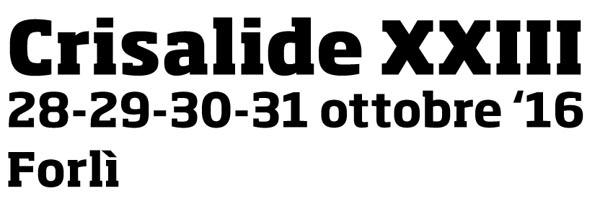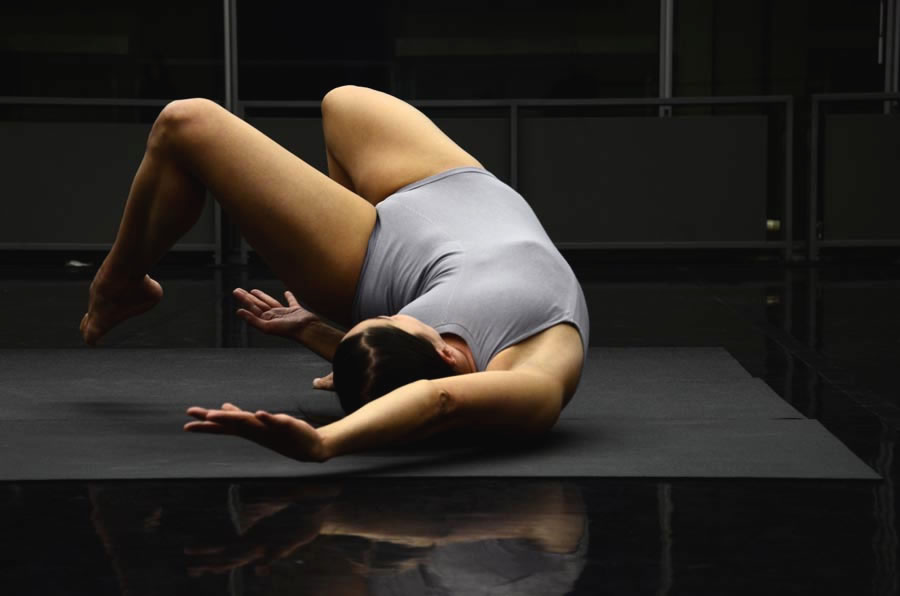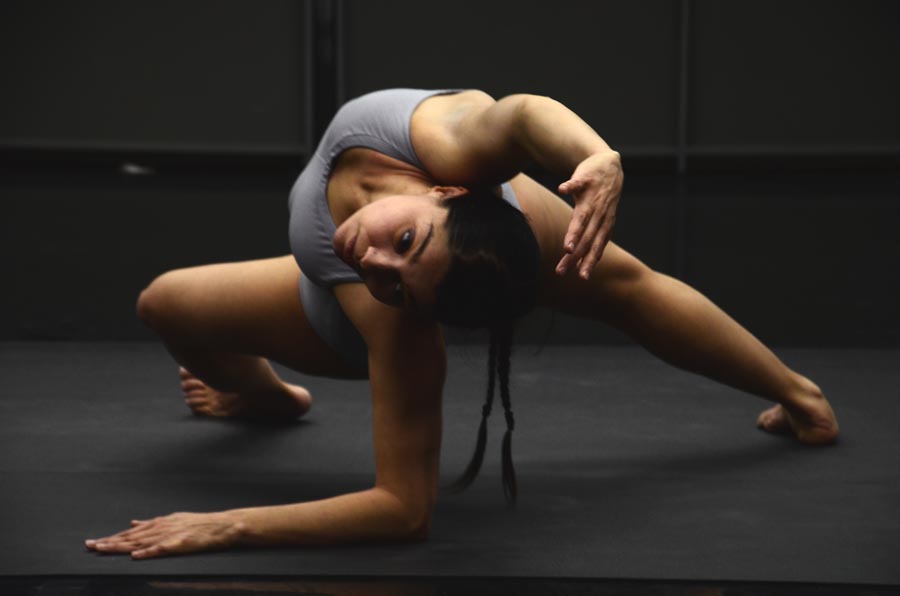| |
Coreografia: Myriam Gourfink
Danza: Deborah Lary
Musiche: Kasper T.Toeplitz
Luci: Kasper Toeplitz
Costumi: Laurence Alquier
Coproduzione le Forum / Scène conventionnée de Blanc-Mesnil, avec le soutien du Conseil général de la Seine-Saint-Denis. L’association LOLdanse est soutenue par le ministère de la Culture et de la Communication, Drac Île-de-France, au titre de l’aide aux compagnies conventionnées. Avec le soutien du Centre National de la Danse (mise à disposition de studios).
Per questo assolo Myriam Gourfink ha creato una partitura che sviluppa ed intreccia tre spazi.
Nel primo, lo spazio “aereo”, domina la percezione della pressione atmosferica, e la danzatrice lavora nello spazio utilizzando come riferimento l’asse mediano del proprio corpo che collega il centro del perineo alla cima del cranio.
Per accentuare la sensazione di questo spazio gassoso e sviluppare una danza in aria, la partitura suggerisce degli appoggi su superfici ridotte, o ancora, costringe l’asse mediano del corpo a evitare l’asse della gravità.
Nel secondo spazio, definito “del luogo”, l’ambiente circostante diventa il referente, ossia un dispositivo di costrizioni spaziali che rivela alla danzatrice i suoi limiti e le sue resistenze, affinché essa possa nominarli e assumerli.
In questa fase, la partitura implica l’utilizzo di “sistemi di contegno di una o più parti del corpo in una direzione precisa o in un punto” dai quali hanno origine movimenti di torsione, rotazione, inversione e capovolgimento.
Nel terzo spazio, definito “terrestre”, la danza cede alla forza di attrazione centrale della Terra. La partitura offre tempi d’integrazione cellulare, di risonanza; tempi di raccoglimento e di aumento delle vibrazioni provocate dal dinamismo stesso della danza. Questa fase della partitura implica, da parte della danzatrice, un lavoro sul viaggio dell’apparato percettivo e del pensiero all’interno del proprio corpo, al fine di veicolare l’energia sull’asse mediano; per prendere tempo e sentire tutte le reazioni. La fase finale di ascolto favorisce l’apparire di forme, entità, consistenze.
Deborah Lary
Nata nel 1977, Deborah Lary, studia danza classica al Conservatorio di Parigi, poi si unisce alla compagnia di Catherine Esarret che riunisce bambini e adulti.
Nel 1999, ottiene il DE in danza contemporanea ai Rencontres Internationales di danza contemporanea (RIDC). Entra in seguito a far parte delle compagnie di Serge Keuten, Faizal Zehgoudi, Arte Los (sicilia), Esther Aumatell (Nantes) e poi il CCN di Karine Saporta.
Nel 2005, scopre il lavoro di Myriam Gourfink e partecipa alla creazione di This is my house. Nel 2006, sviluppa i X event 2 con Les gens d’Uterpan. Al momento sta continuando la sua collaborazione con Myriam Gourfink per la sua prossima opera, ma allo stesso tempo lavora ai suoi progetti con Gens d’Uterpan e ancora con Kirsten Debrock.
Myriam Gourfink
Danzatrice e coreografa nata nel 1968
Le tecniche respiratorie dello yoga fondano l’andatura di Myriam Gourfink. L’idea è quella di ricercare la spinta interiore che porta al movimento. Guidata dal respiro, l’organizzazione degli appoggi è estremamente precisa, la coscienza dello spazio è tenue. La danza è lenta, spessa, in un tempo continuo. Questa conoscenza del movimento e dello spazio permette di ideare coreografie senza una fase di esplorazione in atelier. Grazie a ciò che lei intuisce in una situazione danzata, per sentire la danza non vi è nessun bisogno di muoversi: i sensi e l’intelletto la ricostituiscono senza aver bisogno dell’azione. Così, come i musicisti, ha sviluppato una scrittura simbolica per comporre l’universo geometrico e l’evoluzione poetica della danza.
Avendo studiato la notazione Laban con Jacqueline Challet Haas, è partita da questo sistema per intraprendere la ricerca per formalizzare un suo proprio linguaggio di composizione. Ogni coreografia invita l’interprete ad essere cosciente delle sue azioni e di ciò che lo attraversa. Gli spartiti rendono attiva la sua partecipazione: effettua delle scelte, esegue operazioni, fa fronte a ciò che di inatteso si cela nella scrittura, alla quale risponde immediatamente.
Per alcuni progetti, gli spartiti sono integrati con dei dispositivi (informatici) di perturbazione, di ri-generazione in tempo reale della composizione pre-scritta: il programma gestisce l’insieme dello spartito e genera milioni di possibili svolgimenti. Gli interpreti pilotano –tramite dei sensori- il processo di modifica dello spartito coreografico, che possono leggere su degli schermi LCD. Il dispositivo informatico sta quindi al centro delle relazioni di spazio e di tempo. Permette, mano a mano che l’opera avanza, di strutturare contesti inediti.
Personaggio di spicco della ricerca coreografica in Francia, invitata da numerosi festival internazionali (Springdance a NYC, festival Künsten delle arti a Bruxelles, Festival de La Bâtie a Ginevra, Festival Danças Na Cidade a Lisbona etc.), Myriam Gourfink è stata artista in residenza all’IRCAM nel 2004-2005 e al Fresnoy-studio Nationale delle arti contemporanee nel 2005-2006. Da gennaio 2008 a marzo 2013 ha diretto il programma di ricerca e di composizione coreografica (PRCC) alla Fonzazione Royaumont, da settembre è artista in residenza al Forum de Blanc-Mesnil.
Kasper T. Toeplitz
Compositore/interprete nato nel 1960.
Compositore e musicista (computer e basso elettrico), al di là delle distinzioni troppo comunemente accettate tra musica contemporanea –la “grande”- e musica detta “non accademica”, si occupa di musica elettronica, o noise music. Lavora quindi sia con le grandi istituzioni dello stato (GMEM, GRM, IRCAM, radio-France), sia con musicisti sperimentali o inclassificabili come Eliane Radigue, Zbigniew Kkarkowski, Dror Feiler, Tetsuo Furudate, Phill Niblock, Z’ev o Art Zoyd.
Choreography: Myriam Gourfink
Danse: Deborah Lary
Music: Kasper T.Toeplitz
Lights: Kasper Toeplitz
Costumes: Laurence Alquier
Coproduction le Forum / Scène conventionnée de Blanc-Mesnil, avec le soutien du Conseil général de la Seine-Saint-Denis. L’association LOLdanse est soutenue par le ministère de la Culture et de la Communication, Drac Île-de-France, au titre de l’aide aux compagnies conventionnées. Avec le soutien du Centre National de la Danse (mise à disposition de studios).
With great precision, through slow micro-movements, the dance of Myriam Gourfink explores “the depths of the body” and its secret, innermost perceptions. For this solo, written for dancer Deborah Lary, with original music by Kasper T. Tœplitz, the choreographer mixes three spaces: earth, air and the theatre. The spectator enters another dimension in time, in a search for the poetry of gesture, typical of this unique choreographer.
Translation Deborah Wirick
MYRIAM GOURFINK
Dancer & chorographer born in 1968
The respiratory techniques of yoga are at the source of Myriam Gourfink’s endeavors. The idea is to seek after the inner urge that leads to movement. Guided by breath, the organization of bases of support is extremely exact, while the consciousness of space is shaky. The dance becomes slow, tedious within continuous time. This knowledge of movement and space makes possible the conception of choreographies without studio rehearsal. Thanks to what it suggests of a dance situation, there is no need to move in order to feel dance: the senses and the intellect reconstitute it.
As do musicians, she uses a symbolic writing system to compose the geometrical universe and poetic evolution of dance. Having studied Labanotation with Jacqueline Challet Haas, she undertook a quest, using this system as a point of departure, for the formalizing of her own compositional language. Each choreography encourages the performer to be conscious of his acts and of whatever passes through him. The scores activate his participation : he makes choices, carries out operations, confronts the unexpected within the written text, to which he responds instantly.
For certain projects, the scores include computer programs for the scrambling and real-time re-generation of the pre-written composition : the program runs the score in its entirety and generates millions of possible compositional sequences. The performer, via captor systems, guide the process of modification of the choreographic score, which they read on LCD screens. The computer setup is thus at the core of the space-time relationship. As the piece proceeds, it makes possible the structuring of as yet untried contexts.
A leading figure in choreographic research in France, but also the guest of numerous international festivals (springdance in New York City, the Künsten Arts festival in Brussels, the Festival de la Bâtie in Geneva, the Danças Na Cidade festival in Lisbon etc.), Myriam Gourfink was artist in residence at the IRCAM in 2004-2005 and at the national Fresnoy-studio for contemporary arts in 2005-2006. From january 2008 to march 2013 Myriam Gourfink has been director of the Programm for Choreographic Research and Composition (PRCC) at the Royaumont Foundation. From 2012 to 2015 she is artist in residence at the Forum de Blanc-Mesnil.
APPROACH
When composing and writing my choreographic scores, I use abstract processes and data. I sit at my table and I write in a language that I have been developing since 2002, it’s inspired by Laban cinetography, but is aimed at creating, rather than transcribing, a dance already in existence. What I write for the choreographic composition is constantly evolving, because each piece is structured around a specific environment built on a global vision of the project. I make a collection of concepts that I consider to be connected with my aims, and from those elements I then develop a glossary and then a score. The composition consists in decoding the information contained in the data collected, the relationships between them, and their possible articulations. It’s all about listening, observing, and trying to understand what is at work inside the environment in place.
The dancers who read and interpret the scores use the body technique forming the basis of my work, which relies on awareness of the breath, the circulation and the distribution of the body’s weight, and fluidity.
It was the work of Odile Duboc that guided me in my relationship with gravity. I experienced it in terms of a phase of vertical descent by the weight of the body beneath the earth’s crust, then a phase of listening to what travels up from the earth through the body: it’s like a wave, expanding our internal spaces and propelling movement. In order to examine the body’s spaces in more detail, in 1995 I embarked on an exploration using breath. Yoga helped me to realize the difference between physical respiration and respiration sustained by a thread of breath, it is the latter that has formed the basis of my work ever since. This approach allows you to become aware of the body as a resonating volume, the perception is not only drawn into the internal space, but also the surrounding space, the body is porous, it is suspended in the air. A new challenge is then presented, one that consists of being aware of atmospheric pressure while dancing: experiencing that force, letting oneself become air-borne and showing the onlooker to see the means of support. And then instilling the desire to witness the encounter between each cell and each air molecule. The tiny interstices are measured by perception and this gives rise to a dance that extends, diffracts and, according to some, perhaps even slows time. |
























